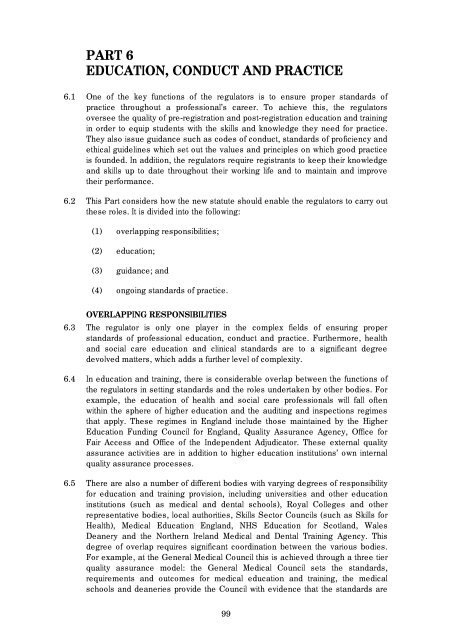Regulation of Health and Social Care Professionals Consultation
Regulation of Health and Social Care Professionals Consultation
Regulation of Health and Social Care Professionals Consultation
You also want an ePaper? Increase the reach of your titles
YUMPU automatically turns print PDFs into web optimized ePapers that Google loves.
PART 6<br />
EDUCATION, CONDUCT AND PRACTICE<br />
6.1 One <strong>of</strong> the key functions <strong>of</strong> the regulators is to ensure proper st<strong>and</strong>ards <strong>of</strong><br />
practice throughout a pr<strong>of</strong>essional’s career. To achieve this, the regulators<br />
oversee the quality <strong>of</strong> pre-registration <strong>and</strong> post-registration education <strong>and</strong> training<br />
in order to equip students with the skills <strong>and</strong> knowledge they need for practice.<br />
They also issue guidance such as codes <strong>of</strong> conduct, st<strong>and</strong>ards <strong>of</strong> pr<strong>of</strong>iciency <strong>and</strong><br />
ethical guidelines which set out the values <strong>and</strong> principles on which good practice<br />
is founded. In addition, the regulators require registrants to keep their knowledge<br />
<strong>and</strong> skills up to date throughout their working life <strong>and</strong> to maintain <strong>and</strong> improve<br />
their performance.<br />
6.2 This Part considers how the new statute should enable the regulators to carry out<br />
these roles. It is divided into the following:<br />
(1) overlapping responsibilities;<br />
(2) education;<br />
(3) guidance; <strong>and</strong><br />
(4) ongoing st<strong>and</strong>ards <strong>of</strong> practice.<br />
OVERLAPPING RESPONSIBILITIES<br />
6.3 The regulator is only one player in the complex fields <strong>of</strong> ensuring proper<br />
st<strong>and</strong>ards <strong>of</strong> pr<strong>of</strong>essional education, conduct <strong>and</strong> practice. Furthermore, health<br />
<strong>and</strong> social care education <strong>and</strong> clinical st<strong>and</strong>ards are to a significant degree<br />
devolved matters, which adds a further level <strong>of</strong> complexity.<br />
6.4 In education <strong>and</strong> training, there is considerable overlap between the functions <strong>of</strong><br />
the regulators in setting st<strong>and</strong>ards <strong>and</strong> the roles undertaken by other bodies. For<br />
example, the education <strong>of</strong> health <strong>and</strong> social care pr<strong>of</strong>essionals will fall <strong>of</strong>ten<br />
within the sphere <strong>of</strong> higher education <strong>and</strong> the auditing <strong>and</strong> inspections regimes<br />
that apply. These regimes in Engl<strong>and</strong> include those maintained by the Higher<br />
Education Funding Council for Engl<strong>and</strong>, Quality Assurance Agency, Office for<br />
Fair Access <strong>and</strong> Office <strong>of</strong> the Independent Adjudicator. These external quality<br />
assurance activities are in addition to higher education institutions’ own internal<br />
quality assurance processes.<br />
6.5 There are also a number <strong>of</strong> different bodies with varying degrees <strong>of</strong> responsibility<br />
for education <strong>and</strong> training provision, including universities <strong>and</strong> other education<br />
institutions (such as medical <strong>and</strong> dental schools), Royal Colleges <strong>and</strong> other<br />
representative bodies, local authorities, Skills Sector Councils (such as Skills for<br />
<strong>Health</strong>), Medical Education Engl<strong>and</strong>, NHS Education for Scotl<strong>and</strong>, Wales<br />
Deanery <strong>and</strong> the Northern Irel<strong>and</strong> Medical <strong>and</strong> Dental Training Agency. This<br />
degree <strong>of</strong> overlap requires significant coordination between the various bodies.<br />
For example, at the General Medical Council this is achieved through a three tier<br />
quality assurance model: the General Medical Council sets the st<strong>and</strong>ards,<br />
requirements <strong>and</strong> outcomes for medical education <strong>and</strong> training, the medical<br />
schools <strong>and</strong> deaneries provide the Council with evidence that the st<strong>and</strong>ards are<br />
99
















